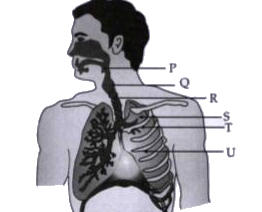When a person breathers in air, the air enters into his body through an organ A having two holes B in it. The air then passes through pharynx and larynx and enters into a tube C. The tube C divides into two smaller tubes D at its lower end. The two smaller tubes are attached to two respiratory organs E. Each smaller tube divides inside the organs E to form a large number of still smaller tubes called F. The smallest tubes F have air-sacs G at their ends in which gaseous exchange takes place in the body of the person. What are A, B, C, D, E, F and G?
The correct Answer is:A = Nose; B = Nostrils; C = Trachea (or Windpipe); D = Bronchi ; E = Lungs ; F = Bronchioles; G = Alveoli
Step by step video, text & image solution for When a person breathers in air, the air enters into his body through an organ A having two holes B in it. The air then passes through pharynx and larynx and enters into a tube C. The tube C divides into two smaller tubes D at its lower end. The two smaller tubes are attached to two respiratory organs E. Each smaller tube divides inside the organs E to form a large number of still smaller tubes called F. The smallest tubes F have air-sacs G at their ends in which gaseous exchange takes place in the body of the person. What are A, B, C, D, E, F and G? by Biology experts to help you in doubts & scoring excellent marks in Class 10 exams.
Topper's Solved these Questions
- BOOK - LAKHMIR SINGH & MANJIT KAURCHAPTER - LIFE PROCESSESEXERCISE - very short answer type question1videos
LIFE PROCESSES
- BOOK - LAKHMIR SINGH & MANJIT KAURCHAPTER - LIFE PROCESSESEXERCISE - short answer type question3videos
LIFE PROCESSES
- BOOK - LAKHMIR SINGH & MANJIT KAURCHAPTER - LIFE PROCESSESEXERCISE - question based on high order thinking skills1videos
LIFE PROCESSES
- BOOK - LAKHMIR SINGH & MANJIT KAURCHAPTER - HOW DO ORGANISMS REPRODUCE EXERCISE - QUESTIONS BASED ON HIGH ORDER THINKING SKILLS (HOTS)27videos
HOW DO ORGANISMS REPRODUCE
- BOOK - LAKHMIR SINGH & MANJIT KAURCHAPTER - MANAGEMENT OF NATURAL RESOURCES EXERCISE - VALUE BASED QUESTIONS25videos
MANAGEMENT OF NATURAL RESOURCES
Similar Questions
Knowledge Check
- Question 1 - Select One
Tube feet are the locomotory organs of
APlatyhelminthesBEchinodermataCMolluscaDArthropoda - Question 2 - Select One
Pollen tube, after reaching the ovary generally enters the ovule through the
AnucellusBintegumentCchalazaDmicropyle - Question 3 - Select One
Commonly the pollen tube enters the ovule through
AHilumBChalazaCFuncileDMicropyle.
Tube feet are the locomotory organs in
View SolutionPropyne when passed through a hot iron tube at 400∘C produces
View SolutionWhen any plane passing through the central axis of the body divides the organism into two identical halves , then this is called
View SolutionWhen pollen tube enters through micropyle, it is called:
View SolutionWhen any plane passing through the central axis of the body divides the organism into two identical halves , then this is called
View Solution


